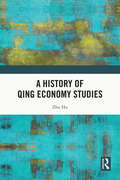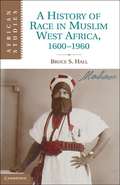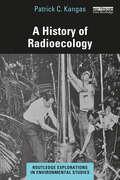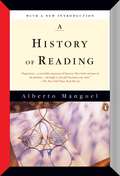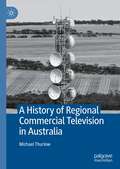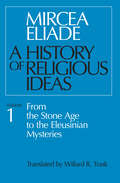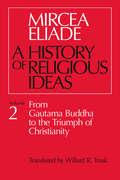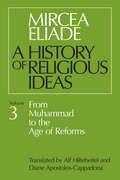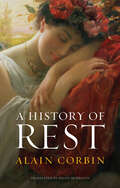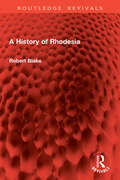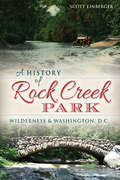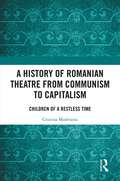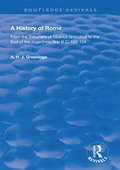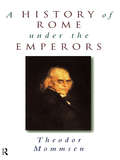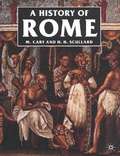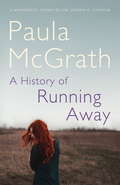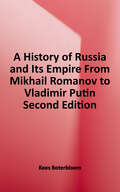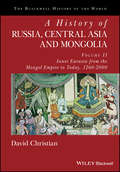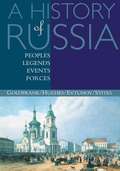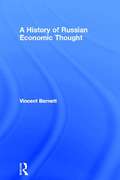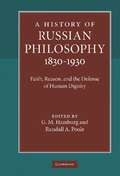- Table View
- List View
A History of Qing Economy Studies
by Zhu HuThis book is a historiographical study of the economic history of the Qing dynasty that systematically examines the research paradigms underlying the range of historical studies conducted over the past century. In reviewing historical studies of the economic history of the Qing dynasty from an epistemological and methodological perspective, the book explores how this research area emerged and developed and explores the three major paradigms that dominate the field: the revolutionary historical paradigm based on productive relations; the modernization paradigm centring on productivity and the Chinese-centric approach that seeks to understand the internal momentum of economic development. It is shown that shifts in paradigms derive not only from the linear derivation of academic ideas but are also closely related to wider changes in society and social discourse. Hence, the author proposes an approach that studies economic and social history with an emphasis on social practice, shedding light on a better understanding of the direction of China’s economic history. The title will benefit scholars and students interested in economic history and modern Chinese history.
A History of Race in Muslim West Africa, 1600–1960
by Bruce S. HallThe mobilization of local ideas about racial difference has been important in generating, and intensifying, civil wars that have occurred since the end of colonial rule in all of the countries that straddle the southern edge of the Sahara Desert. From Sudan to Mauritania, the racial categories deployed in contemporary conflicts often hearken back to an older history in which blackness could be equated with slavery and non-blackness with predatory and uncivilized banditry. This book traces the development of arguments about race over a period of more than 350 years in one important place along the southern edge of the Sahara Desert: the Niger Bend in northern Mali. Using Arabic documents held in Timbuktu, as well as local colonial sources in French and oral interviews, Bruce S. Hall reconstructs an African intellectual history of race that long predated colonial conquest, and which has continued to orient inter-African relations ever since.
A History of Radioecology (Routledge Explorations in Environmental Studies)
by Patrick C. KangasThis book presents a history of radioecology, from World War II through to the critical years of the Cold War, finishing with a discussion of recent developments and future implications for the field. Drawing on a vast array of primary sources, the book reviews, synthesizes and discusses the implications of the ecological research supported by the Atomic Energy Commission (AEC) of the United States government, from World War II to the early 1970s. This was a critical period in the history of ecology, characterized by a transition from the older, largely descriptive studies of communities of plants and animals to the modern form of the science involving functional studies of energy flow and mineral cycling in ecosystems. This transition was in large part due to the development of radioecology, which was a by-product of the Cold War and the need to understand and predict the consequences of a nuclear war that was planned but has never occurred. The book draws on important case studies, such as the Pacific Proving Grounds, the Nevada Test Site, El Verde in Puerto Rico, the Brookhaven National Laboratory and recent events such as the nuclear disasters at Chernobyl and Fukushima. By revisiting studies and archived information from the Cold War era, this book offers lessons from the history of radioecology to provide background and perspective for understanding possible present-day impacts from issues of radiation risks associated with nuclear power generation and waste disposal. Post-Cold War developments in radioecology will be also reviewed and contrasted with the AEC-supported ecology research for further perspectives. This book will be of great interest to students and scholars of radioecology, environmental pollution, environmental technology, bioscience and environmental history.
A History of Reading
by Alberto ManguelA History of Reading is a wonderful celebration of the one invention that has done most for the human race. From clay tablets to CD-ROM, from book thieves to book burners, bibliophiles, book fools and saints, noted essayist Alberto Manguel follows the quirky and passionate 4000-year-old history of the written word whose true hero is the reader. For those who love reading, this, at long last, is their story.
A History of Reading
by Alberto ManguelAt one magical instant in your early childhood, the page of a book--that string of confused, alien ciphers--shivered into meaning. Words spoke to you, gave up their secrets; at that moment, whole universes opened. You became, irrevocably, a reader. Noted essayist Alberto Manguel moves from this essential moment to explore the 6000-year-old conversation between words and that magician without whom the book would be a lifeless object: the reader. Manguel lingers over reading as seduction, as rebellion, as obsession, and goes on to trace the never-before-told story of the reader's progress from clay tablet to scroll, codex to CD-ROM.
A History of Reading
by Alberto ManguelAt one magical instant in your early childhood, the page of a book--that string of confused, alien ciphers--shivered into meaning, and at that moment, whole universes opened. You became, irrevocably, a reader. Noted essayist and editor Alberto Manguel moves from this essential moment to explore the six-thousand-year-old conversation between words and that hero without whom the book would be a lifeless object: the reader. Manguel brilliantly covers reading as seduction, as rebellion, and as obsession and goes on to trace the quirky and fascinating history of the reader's progress from clay tablet to scroll, codex to CD-ROM.
A History of Regional Commercial Television in Australia
by Michael ThurlowThis book is the first history of commercial television in regional Australia, where diverse communities are spread across vast distances and multiple time zones. The first station, GLV Latrobe Valley, began broadcasting in December 1961. By the late 1970s, there were 35 independent commercial stations throughout regional Australia, from Cairns in the far north-east to Bunbury in the far south-west. Based on fine-grained archival research and extensive interviews, the book examines the key political, regulatory, economic, technological, industrial, and social developments which have shaped the industry over the past 60 years. Regional television is often dismissed as a mere extension of – or footnote to – the development of Australia’s three metropolitan commercial television networks. Michael Thurlow’s study reveals an industry which, at its peak, was at the economic and social heart of regional communities, employing thousands of people and providing vital programming for viewers in provincial cities and small towns across Australia.
A History of Religion in 5½ Objects
by S. Brent PlateA leading scholar explores the importance of physical objects and sensory experience in the practice of religion. Humans are needy. We need things: objects, keepsakes, stuff, tokens, knickknacks, bits and pieces, junk, and treasure. We carry special objects in our pockets and purses, and place them on shelves in our homes and offices. As commonplace as these objects are, they can also be extraordinary, as they allow us to connect with the world beyond our skin. A History of Religion in 5½ Objects takes a fresh and much-needed approach to the study of that contentious yet vital area of human culture: religion. Arguing that religion must be understood in the first instance as deriving from rudimentary human experiences, from lived, embodied practices, S. Brent Plate asks us to put aside, for the moment, questions of belief and abstract ideas. Instead, beginning with the desirous, incomplete human body (symbolically evoked by "½"), he asks us to focus on five ordinary types of objects--stones, incense, drums, crosses, and bread--with which we connect in our pursuit of religious meaning and fulfillment. As Plate considers each of these objects, he explores how the world's religious traditions have put each of them to different uses throughout the millennia. We learn why incense is used by Hindus at a celebration of the goddess Durga in Banaras, by Muslims at a wedding ceremony in West Africa, and by Roman Catholics at a Mass in upstate New York. Crosses are key not only to Christianity but to many Native American traditions; in the symbolic mythology of Peru's Misminay community, cruciform imagery stands for the general outlay of the cosmos. And stones, in the form of cairns, grave markers, and monuments, are connected with places of memory across the world. A History of Religion in 5½ Objects is a celebration of the materiality of religious life. Plate moves our understanding of religion away from the current obsessions with God, fundamentalism, and science--and toward the rich depths of this world, this body, these things. Religion, it turns out, has as much to do with our bodies as our beliefs. Maybe even more.From the Hardcover edition.
A History of Religious Ideas Volume 1: From the Stone Age to the Eleusinian Mysteries (A History of Religious Ideas #1)
by Mircea Eliade&“Everyone who cares about the human adventure will find new information and new angles of vision.&”—Martin E. Marty, The New York Times Book Review This extraordinary work delves into the subject of religion in the prehistoric and ancient worlds—humankind&’s earliest quests for meaning. From Neanderthal burials to the mythology of the Iron Age, to the religions of Mesopotamia, Egypt, Greece, Israel, India, and beyond, it offers both an appreciation of the wide-ranging diversity of religious expression—and a consideration of the fundamental unity of religious phenomena. &“Will arouse the interest of all historians of western religion, since it includes chapters on the religions of Canaan and Israel. However, the book must be read cover to cover if one wants to grasp the significance of its gigantic historical scope.&”—Church History
A History of Religious Ideas, Volume 1: From the Stone Age to the Eleusinian Mysteries
by Mircea EliadeNo one has done so much as Mr. Eliade to inform literature students in the West about 'primitive' and Oriental religions. . . . Everyone who cares about the human adventure will find new information and new angles of vision. --Martin E. Marty, New York Times Book Review"
A History of Religious Ideas, Volume 2: From Gautama Buddha to the Triumph of Christianity
by Mircea EliadeThe second volume of the extraordinary history that &“should be an essential resource for generations to come&” (Parabola). In volume two of this monumental work, Mircea Eliade continues his magisterial progress through the history of religious ideas. The religions of ancient China, Brahmanism and Hinduism, Buddha and his contemporaries, Roman religion, Celtic and German religions, Judaism, the Hellenistic period, the Iranian syntheses, and the birth of Christianity—all are encompassed in this volume. Praise for A History of Religious Ideas &“Everyone who cares about the human adventure will find new information and new angles of vision here.&”—The New York Times &“The culmination of years of impassioned scholarship…rendered with the talent of one who is not only an academic writer but a novelist of considerable distinction.&”—Times Higher Education Supplement
A History of Religious Ideas: From Muhammad to the Age of Reforms (A History of Religious Ideas)
by Mircea EliadeThe conclusion of the three-volume history “rendered with the talent of one who is not only an academic writer but a novelist of considerable distinction” (David J. Levy, Times Higher Education Supplement).In A History of Religious Ideas. Mircea Eliade examines the movement of Jewish thought out of ancient Eurasia, the Christian transformation of the Mediterranean area and Europe, and the rise and diffusion of Islam from approximately the sixth through the seventeenth centuries. Eliade’s vast knowledge of past and present scholarship provides a synthesis that is unparalleled. In addition to reviewing recent interpretations of the individual traditions, he explores the interactions of the three religions and shows their continuing mutual influence to be subtle but unmistakable.As in his previous work, Eliade pays particular attention to heresies, folk beliefs, and cults of secret wisdom, such as alchemy and sorcery, and continues the discussion, begun in earlier volumes, of pre-Christian shamanistic practices in northern Europe and the syncretistic tradition of Tibetan Buddhism. These subcultures, he maintains, are as important as the better-known orthodoxies to a full understanding of Judaism, Christianity, and Islam.Acclaim for A History of Religious Ideas“Everyone who cares about the human adventure will find new information and new angles of vision.” —Martin E. Marty, The New York Times Book Review“The volumes would be worth buying for the critical bibliographies alone, but far more than this, they represent the culmination of years of impassioned scholarship.” —David J. Levy, Times Higher Education Supplement“This multivolume work should be an essential resource for generations to come.” —John Loudon, Parabola
A History of Rest
by Alain CorbinRest occupies a space outside of sleep and alertness: it is a form of recuperation but also of preparation for what is to come, and is a need felt by human and animal alike. Through the centuries, different and conflicting definitions and forms of rest have blossomed, ranging from heavenly repose to what is prescribed for the modern affliction of burn-out. What has remained constant is its importance: long the subject of art and literature, everyone understands the need not to disturb the aimless, languishing, daydreaming Lotus-eater. Not viewed simply as an antidote for fatigue, for a long time rest was seen as the prelude to eternal life, until everything changed in the nineteenth century and society entered the great ‘age of rest’. At this point, the renowned French historian Alain Corbin explains, rest took on new therapeutic and leisurely qualities, embodied by the new types of human that emerged. The modern epicurean frolicked on beaches and soaked up the rays, while melancholics were rejuvenated in pristine sanatoria, the new temples of rest. Paid holidays and a widespread acceptance of the need to build up the strength sapped during work followed, while the 1950s became the decade of ‘sea, sex and sun’. This new book, as original as Corbin’s other histories of neglected aspects of human life, pans the long evolution of rest in a highly readable and engaging style.
A History of Rhodesia (Routledge Revivals)
by Robert BlakeFirst published in 1977, A History of Rhodesia is a history of the origins and course of modern European occupation of ‘Southern Rhodesia’, ‘Rhodesia’ as it has been termed since the old ‘Northern Rhodesia’ became independent under the name Zambia in 1963. Robert Blake describes the years of the Monomotapa; the Portuguese occupation in the sixteenth and seventeenth centuries; the Ndebele kingdom of the nineteenth century; the advent of Cecil Rhodes and the establishment of the Chartered Company which ruled Rhodesia until 1922; the period Southern Rhodesia enjoyed a self-governing colony from 1923 to 1951; the years of the Central African Federation from 1953 to its dissolution in 1963; and finally the dramatic course of events which led to Ian Smith’s government making a unilateral declaration of independence in 1965. The years since UDI are covered by a long epilogue that takes the story forward to the early months of 1977.Rhodesian history is a strange and intriguing compound of romance, idealism, courage, arrogance, avarice and accident. Rhodesia’s story is not only that of economic, political, ideological and external forces which have shaped it—it is also that of the individuals who made—or failed to make decisions: Rhodes, Lobengula, Jameson, Lord Malvern, Roy Welensky, Garfield Todd, Joshua Nkomo, Ian Smith.Written with access to many collections of papers not normally available to historians, Robert Blake’s book is a major contribution to the history of colonial and post-colonial Africa.
A History of Rock Creek Park: Wilderness & Washington, D.C. (Landmarks)
by Scott EinbergerWashington, D.C.'s Rock Creek Park stands as a wild and wonderful natural gem among a burgeoning metropolis. But while local residents flock to its trails and roads on weekends to hike, jog and bicycle, they are largely unaware of its diverse history. The park's grounds were the site of the bloody Civil War Battle of Fort Stevens, and presidents like Theodore Roosevelt and Woodrow Wilson exercised and picnicked in the park the same way many visitors do today. From the cabin of eccentric poet Joaquin Miller to the oldest house in Washington today, the many stories and legends surrounding the park are sure to entertain and inform. Join National Park ranger, author and historian Scott Einberger as he traces the human, natural and urban history of Rock Creek Park, the largest park in the nation's capital.
A History of Romanian Theatre from Communism to Capitalism: Children of a Restless Time
by Cristina ModreanuA History of Romanian Theatre from Communism to Capitalism analyses the last three decades of Romanian theatre and connects it to the international stage. Cristina Modreanu questions the relationship between artists and power, both before 1989, behind the Iron Curtain, and in the current global political context, with nationalism manifesting itself in Eastern Europe, as seen in the critical work of Romanian theatre makers. This study covers the complex cases of theatre makers such as Lucian Pintilie, Liviu Ciulei and Andrei Șerban, who built their international careers in exile, and the most innovative Romanian artists of today, such as Silviu Purcărete, Mihai Măniuţiu, Gianina Cărbunariu, Radu Afrim, and Bogdan Georgescu, who reached the status of transglobal artists. Filling a considerable gap in Romanian theatre discourse, this book will be of a great interest to students and scholars of contemporary theatre and history.
A History of Rome from 133 B.C. to 70 A.D.: From the Tribunate of Tiberius Gracchus to the End of the Jugerthine War (Routledge Revivals)
by A.H.J. GreenidgeFirst published in 1904, this volume began what was to be the magnum opus of the highly regarded Classical scholar, A.H.J. Greenidge. Though published posthumously, the work stands alone as a valuable contribution to Classical history. Beginning with a socioeconomic history which exposes the conditions preceding and determining the great conflict of interests to follow, Greenidge then explores the story of Rome from Scipio Aemilianus and the Gracchi brothers until the second election of Marius to the consulship.
A History of Rome under the Emperors
by Theodor MommsenThis book caused a sensation when it was published in Germany in 1992, and was front page news in many newspapers. For readers of English, it will be an authoritative survey of four centuries of Roman history, and a unique window on the German tradition of the last century.Theodor Mommsen (d. 1903) was one of the greatest Roman historians of the nineteenth century, and the only one ever to be awarded the Nobel Prize for Literature. His fame rests on his History of Rome as well as his work on Roman law and on the Roman provinces. But the work that would have concluded his history of Rome - which ran to the reign of Augustus - was never completed. This book represents that great lost work.In 1980 Alexander Demandt discovered in an antiquarian bookshop a full and detailed handwritten transcript of the lectures on the Roman Empire, which Mommsen gave for many years from 1863 to 1886, made by two of his students. This transcript has been edited to provide the authoritative reconstruction of the book Mommsen never wrote, A History of Rome Under the Emperors.Barbara and Alexander Demandt have carefully edited the text and provided detailed annotation and explanatory references. For the English edition, Professor Thomas Wiedemann has written an introduction which surveys Mommsen's position and influence in nineteenth century German scholarship and introduces his work for English speaking readers.
A History of Rome: Down to the Reign of Constantine
by M. Cary H. H. ScullardA classic survey of Roman history, art, economic life, and religion through Constantine's rise to power.
A History of Running Away
by Paula McGrathBook of the Year in the Irish Times'A wonderful storyteller' Joseph O'ConnorIn 1982 Jasmine wants to box, but in 1980s Ireland boxing is illegal for girls.In 2012 a gynaecologist agonises about a job offer which would mean escape from the increasingly fraught atmosphere of her Dublin hospital. But what about her mother, stuck in a nursing home?And in Maryland Ali, whose mother has recently died, hooks up with a biker gang to escape from grandparents she didn't know she had.Gradually revealing the unexpected connections between the three women, A History of Running Away is a brilliantly written novel about running away, growing up and finding out who you are.
A History of Russia and its Empire: From Mikhail Romanov to Vladimir Putin
by Kees BoterbloemThis clear and focused text provides an introduction to imperial Russian and Soviet history from the crowning of Mikhail Romanov in 1613 to Vladimir Putin's new term. Through a consistent chronological narrative, Kees Boterbloem considers the political, military, economic, social, religious, and cultural developments and crucial turning points that led Russia from an exotic backwater to superpower stature in the twentieth century. The author assesses the tremendous price paid by those who made Russia and the Soviet Union into such a hegemonic power, both locally and globally. He considers the complex and varied interactions between Russians and non-Russians and investigates the reasons for the remarkable longevity of this last of the colonial powers, whose dependencies were not granted independence until 1991. He explores the ongoing legacies of this fraught decolonization process on the Russian Federation itself and on the other states that succeeded the Soviet Union. The only text designed and written specifically for a one-semester course on this four-hundred-year period, it will appeal to all readers interested in learning more about the history of the people who have inhabited one-sixth of the earth's landmass for centuries.
A History of Russia, Central Asia and Mongolia, Volume II: Inner Eurasia from the Mongol Empire to Today, 1260 - 2000 (Blackwell History of the World #Vol. I)
by David ChristianProvides an all-encompassing look at the history of Russia, Central Asia, and Mongolia Beginning with the breakup of the Mongol Empire in the mid-thirteenth century, Volume II of this comprehensive work covers the remarkable history of “Inner Eurasia,” from 1260 up to modern times, completing the story begun in Volume I. Volume II describes how agriculture spread through Inner Eurasia, providing the foundations for new agricultural states, including the Russian Empire. It focuses on the idea of “mobilization”—the distinctive ways in which elite groups mobilized resources from their populations, and how those methods were shaped by the region’s distinctive ecology, which differed greatly from that of “Outer Eurasia,” the southern half of Eurasia and the part of Eurasia most studied by historians. This work also examines how fossil fuels created a bonanza of energy that helped shape the history of the Communist world during much of the twentieth century. Filled with figures, maps, and tables to help give readers a fuller understanding of what has transpired over 750 years in this distinctive world region, A History of Russia, Central Asia and Mongolia: Volume II: Inner Eurasia from the Mongol Empire to Today, 1260-2000 is a magisterial but accessible account of this area’s past, that will offer readers new insights into the history of an often misunderstood part of the world. Situates the histories of Russia, Central Asia, and Mongolia within the larger narrative of world history Concentrates on the idea of Inner Eurasia as a coherent ecological and geographical zone Focuses on the powerful ways in which the region’s geography shaped its history Places great emphasis on how “mobilization” played a major part in the development of the regions Offers a distinctive interpretation of modernity that highlights the importance of fossil fuels Offers new ways of understanding the Soviet era A History of Russia, Central Asia and Mongolia: Volume II is an ideal book for general audiences and for use in undergraduate and graduate courses in world history.
A History of Russia: Peoples, Legends, Events, Forces
by Catherine Evtuhov Richard Stites Lindsey Hughes David GoldfrankA History of Russia: Peoples, Legends, Events, Forces is a comprehensive narrative conceived and developed after the collapse of the former Soviet Union. Informed by the burgeoning historiography of the 1990s, the text balances political and economic explorations of everyday life, social roles, cultural dynamics, and gender issues.
A History of Russian Economic Thought (The Routledge History of Economic Thought)
by Vincent BarnettThe collapse of the Union of Soviet Socialist Republic at the end of the 1980’s was conceived as a victory for capitalist democracy. Here, Vincent Barnett provides the first comprehensive account of the historical development of Russian and Soviet economic thought across the nineteenth and twentieth centuries, and considers its future in the twenty-first century. Utilizing an extensive range of historical sources, Barnett examines the different strands of thought, including classical, neoclassical, historical, socialist, liberal and Marxian schools. He traces their influence, and the impact their ideas had on shaping policies. An excellent addition to the Routledge History of Economic Thought series, this book covers pre-1870, Tsarist economics, the late Tsarist period, the impact of the war, Bolshevik economics, Stalinist economics, Russian economics after 1940. Incorporating a detailed timeline of the most significant Russian economists work and analyzing the effects of historical discontinuities on the institutional structure of Russian economics as a discipline, Barnett delivers an essential text for postgraduates and professionals interested in economic history and the evolution of Russian economic thought.
A History of Russian Philosophy 1830-1930
by G. M. Hamburg Randall A. PooleThe great age of Russian philosophy spans the century between 1830 and 1930 - from the famous Slavophile-Westernizer controversy of the 1830s and 1840s, through the 'Silver Age' of Russian culture at the beginning of the twentieth century, to the formation of a Russian 'philosophical emigration' in the wake of the Russian Revolution. This volume is a major new history and interpretation of Russian philosophy in this period. Eighteen chapters (plus a substantial introduction and afterword) discuss Russian philosophy's main figures, schools, and controversies, while simultaneously pursuing a common central theme: the development of a distinctive Russian tradition of philosophical humanism focused on the defence of human dignity. As this volume shows, the century-long debate over the meaning and grounds of human dignity, freedom, and the just society involved thinkers of all backgrounds and positions, transcending easy classification as 'religious' or 'secular'. The debate still resonates strongly today.
